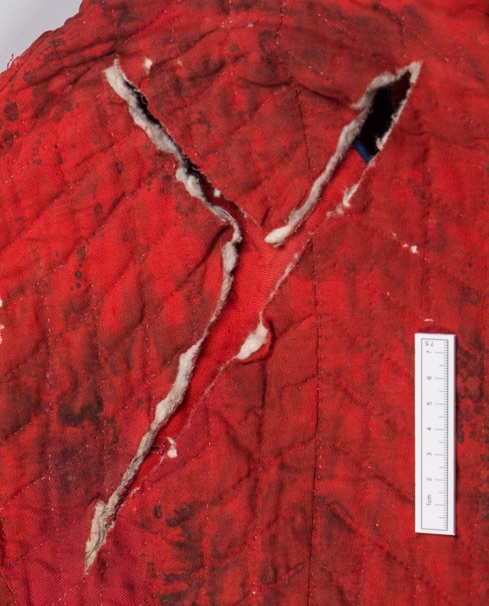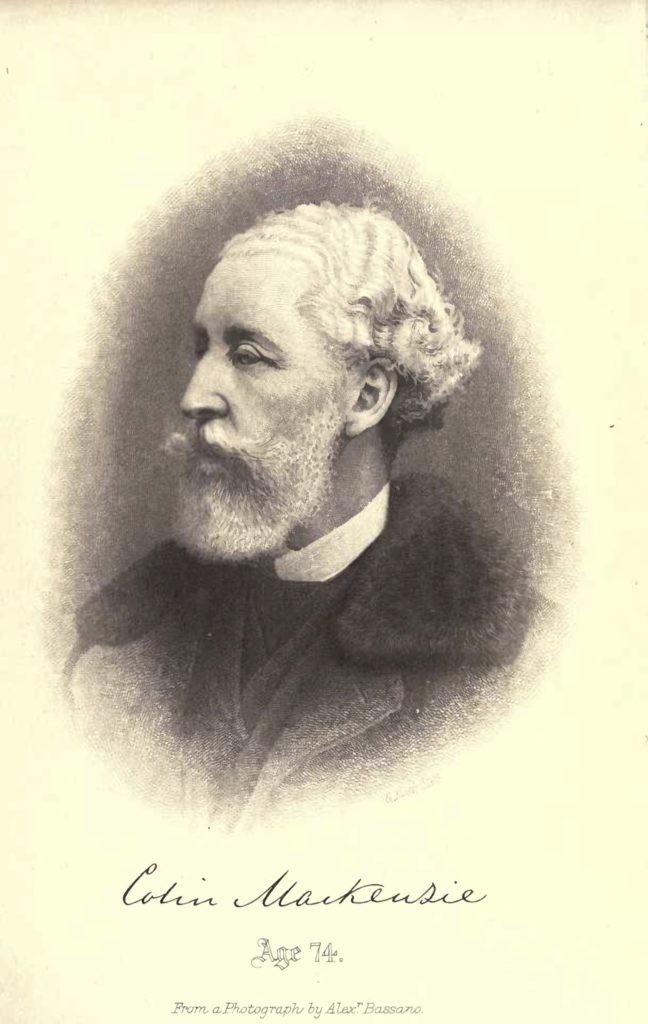
by Hannah Vickers, 2nd year student, MPhil Textile Conservation
*warning: contains a graphic description of violence which some may find upsetting*
Here at the Centre it’s unusual to know any detail about the history of the objects we work on. We can make educated guesses as to why a garment might be stained or torn, but never expect to learn all the facts. On the rare occasion we do discover more detail, this knowledge is likely to majorly influence the conservation treatment carried out.
For my final project of the second year, I’m very privileged to be currently treating a jacket with a well-documented – and startlingly visible – history. The jacket is striking, not only for it’s vivid scarlet red twill wool, closely-fitting military cut and unusual quilted construction, but also because it bears extensive dark brown stains and prominent slashes.


As it turns out, these marks are blood stains and sabre cuts. They are graphic evidence of an attack on the jacket’s wearer, an officer and political agent in the Indian Army called Colin Mackenzie (1806-1888), who I’d previously encountered through an Afghan coat with a no less exciting story.* Through accounts published by Mackenzie and his wife, Helen Douglas Mackenzie, I was able to pinpoint the date and events surrounding the attack. On Friday, 21st September 1855, Mackenzie was attacked by mutinying soldiers in Bolarum, a district of Hyderabad in India. It resulted from a dispute over orders to move a religious procession, revealing deep tensions between local soldiers and British officers such as Mackenzie, who attempted to enforce the directives of the East India Company, and by extension, the British Government.

According to an “anonymous account” published shortly after the attack (probably by Mackenzie himself), the attack occurred as follows:
“[a man] struck him a violent blow with a sword on the head. Sabre-cuts followed in rapid succession; one split the skull, another severed the outer bone of the left arm, a third cut the deltoid to the bone, two others took off the middle finger of the right hand, and severed all the tendons and bones at the back of it…Streaming with blood, God gave him such strength that he actually outran his pursuers, though they were after him like a pack of hungry wolves. As he mounted the steps one or two overtook him, and gave him two tremendous gashes on the back, one of them eleven inches long.”
Mackenzie succeeded in reaching his house, where his wife examined his wounds, finding that “he had parried most of the blows with his arms, each of which had received four sabre-cuts; his thickly-wadded coat had also helped to save him.” Indeed, the slashes on the jacket (of which there are twenty in total) are largely on the sleeves, and the bloodstains are particularly extensive on the lining, rendering the fabric stiff and brittle in places. The fitted jacket and its quilted fabric may have had the two-fold benefit of keeping Mackenzie warm and applying pressure to and sealing the wounds, thus stemming the flow of blood and limiting blood loss.
Much to the surprise of his doctors, Mackenzie survived the attack, and lived to the ripe old age of 82. He kept the jacket as a memento of his remarkable survival and as evidence of the attack, partly to attempt to vindicate himself of blame. His decision to keep the jacket in its bloodstained, tattered state was clearly intentional.
After Mackenzie’s death in 1888, his widow donated the jacket to the Provost of Annan, who in turn donated it to Annan Museum.
My role is now to conserve the jacket for display in Annan Museum, and to stabilise the areas of damage without obscuring them. Stay tuned for a follow-up post on the treatment..
Bibliography
Anonymous. Narrative of the mutiny at Bolarum in September 1855: for the information of Brigadier Colin Mackenzie’s family and private friends. Edinburgh: Murray and Gibb, 1857.
Arbuthnot, A. J. “Mackenzie, Colin (1806–1881).” In Oxford Dictionary of National Biography, edited by H. C. G. Matthew and Brian Harrison. Oxford: OUP, 2004. Online ed., edited by Lawrence Goldman, 2004. Accessed January 29, 2016. http://www.oxforddnb.com/view/article/17574.
Mackenzie, Helen Douglas. Storms and sunshine of a soldier’s life: Lt.-General Colin Mackenzie, CB, 1825-1881. Vol. 1. David Douglas, 1884.
National Army Museum. “Captain Colin Mackenzie (1806-61), Madras Army, Lately a Hostage in Caubool, in His Affghan Dress, c.1842.” Accessed 30th January 2016. http://www.nam.ac.uk/collection/collection-news/your-paintings/captain-colin-mackenzie#pcf-image.


Colin is my 4th Great Grandfather and I’m amazed that he survived this attack! Thank you for this detailed report.
Regards
Deborah